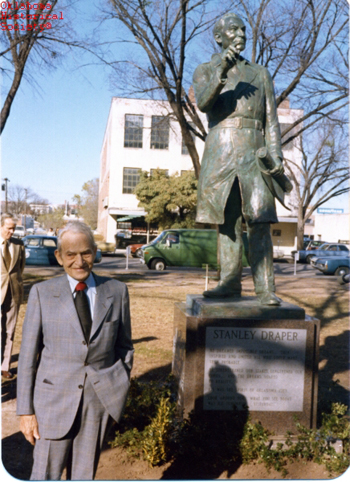
The Encyclopedia of Oklahoma History and Culture
DRAPER, STANLEY CARLISLE (1889–1976).
Popularly known as "Mr. Chamber of Commerce," Oklahoma City civic leader Stanley Carlisle Draper was born November 21, 1889, on a farm near Lasker, North Carolina. His parents, Chesley Winfield and Cornelia Rosetta (Draper) Draper, were of Scotch-Irish descent. Stanley Draper and his eight siblings worked on their father's farm, but the young Draper was eager to see the world beyond his home. At age nineteen he gained a teacher's certificate and taught school. With his teaching salary and money earned at odd jobs such as secretary for the local Modern Woodmen of America, he paid his tuition at the Shenandoah Institute in Dayton, Virginia. After graduating from the Dayton college, Draper attended the University of Chicago. However, World War I interrupted his education.
After his discharge from the U.S. Army, Draper came to Oklahoma City in 1919, and he became membership secretary for the chamber of commerce. He served as the chamber's assistant manager from 1923 to 1930 and then became managing director, the position he held until his retirement in 1968. During his forty-nine years with the Oklahoma City Chamber of Commerce, Oklahoma City's population quadrupled. To meet the community's economic and social needs Draper was instrumental in locating Midwest Air Depot, now Tinker Air Force Base, and the Civil Aeronautics Administration Center, now Federal Aeronautical Administration Center, in Oklahoma City in 1941 and 1946, respectively. He led the efforts to move the railroad tracks from the downtown area to accommodate the building of the Civic Center. He worked on the development of Lake Hefner and a pipeline from Atoka, Oklahoma, to provide the city with water resources. The reservoir for the water piped from Atoka was dedicated in 1964 and named Lake Stanley Draper in his honor.
Inducted into the Oklahoma Hall of Fame in 1957, Draper was a Democrat in politics, a Methodist, and a Rotarian. He was a member of the Oklahoma Historical Society, the Masonic fraternity, and the American Legion. Because he had foreseen the potential benefits of integrating the University of Oklahoma medical school, the Veterans Administration Hospital, and the Oklahoma Medical Research Foundation into a medical center, which had come to fruition in 1946, Draper was inducted into the Oklahoma Medical Sciences Hall of Fame in October 1959. He advocated the formation of the Frontiers of Science Foundation, organized in 1955. During his retirement he volunteered at the Oklahoma Heritage Association, housed at the Hefner Mansion. Draper launched a fund-raising drive to restore the building and to establish the Anthony Oklahoma Heritage Gardens on its grounds. After serving Oklahoma City for fifty-seven years, Draper died of heart failure at St. Anthony Hospital in Oklahoma City on January 8, 1976. Buried in Rose Hill Cemetery, he was survived by his wife, Grace Anne Schmelzenbach Draper, and three children.
See Also
FRONTIERS OF SCIENCE FOUNDATION OF OKLAHOMA, INC., OKLAHOMA HALL OF FAME, TINKER AIR FORCE BASE






